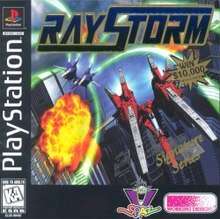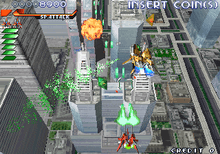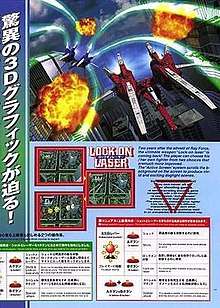RayStorm
RayStorm is a scrolling shooter developed by the Taito Corporation. Originally released in Japan as an arcade game in 1996, it was ported to Sony's PlayStation game console in 1997, to the Sega Saturn (under the name Layer Section II) in that same year, and to Windows-based personal computers in 2001. It was published for the PlayStation in North America by Working Designs. The PlayStation version was also released in Europe by SCE Europe. It was re-released in 2010 with improved graphics, as RayStorm HD, for the Xbox 360 and the PlayStation 3 (with the latter version released exclusively in Japan). In 2012, RayStorm was also released for iOS and in 2017 for Android.
| RayStorm | |
|---|---|
 North American front cover art, published under the Working Designs "Spaz" label. | |
| Developer(s) | Taito |
| Publisher(s) | Taito (Arcade, PS, PSN, XBLA) Mediaquest (Saturn) CyberFront Corporation (Windows) Sourcenext (Windows)
|
| Director(s) | Tomohisa Yamashita Yukio Abe Tatsuo Nakamura |
| Producer(s) | Yukio Abe |
| Composer(s) | Tamayo Kawamoto |
| Series | Ray |
| Platform(s) | Arcade, Sega Saturn, PlayStation, Windows 95, Xbox 360, PlayStation 3, iOS, Android, |
| Release | 1996
|
| Genre(s) | Scrolling shooter |
| Mode(s) | Single player, multiplayer |
| Cabinet | Horizontal |
| Arcade system | Taito FX-1[3] |
| Display | Raster (Horizontal) |
The game is set hundreds of years in the future. Players must pilot their "R-Gray" spacecraft through eight vertically scrolling stages and shoot down enemy ships and vehicles to prevent the forces of the Secilia Federation, a rebellious group of colonies, from destroying Earth. The arcade versions let each player choose one of two ships; home ports include additional ships and features.
RayStorm is one of three "Ray" games, all featuring similar gameplay, released by Taito. RayForce was released before RayStorm, and the RayForce prequel RayCrisis was released after the others. RayStorm is most distinguished from its predecessor by its usage of polygon-based ships instead of sprites.[3] The plot of RayStorm, which is minimally revealed in the game itself but further described by the game's instruction manual and "Extra Mode" in home releases, is not connected to the "Con-Human" storyline of the other two games. The PlayStation version was generally well received by American reviewers due to its graphical style and cutting edge visual effects, but criticized for the simplistic and dated gameplay.
Gameplay

RayStorm is a shoot 'em up. The player views their ship from a distanced perspective while gunning down enemies in the game's vertically scrolling stages. At the beginning of the game, the player must choose one of two ships; a third secret ship is available in ported versions.
The player uses a vulcan-like laser weapon as their primary offense, and a missile weapon which can lock onto multiple targets and gain a combo multiplier, accumulating into a point total. Additionally, each ship has two special maneuvers. The Special Attack is initiated when the player fills a bar to the maximum by engaging in multiple lock-ons. When full the player can unleash a massive screen wide attack with a brief period of invincibility afterwards. The second, the Hyper Laser Assault, executes a special attack unique to each ship, and is performed by setting all available lock-on attacks on a single target and firing.
The ships have slightly differing methods of destroying enemies and attaining a big point total:
- The R-Gray 1 uses a basic single laser cannon with shots that spread out. By moving the reticule over various enemies, it can lock on and fire multiple missiles. This ship is best suited for beginners.
- The R-Gray 2 uses twin lasers, and its attack power is considered superior to the R-Gray 1, but the width and range of its fire is decreased. However, its lock on maximum is 16 targets, meaning its point accumulation is much higher.
Modes
Home versions contain two gameplay modes: the Arcade Mode which preserves the look and feel of the original arcade version, and the Extra Mode that has enhanced graphics, additional enemies, modified bosses, and tougher difficulty,[4] as well as a different ending. Also in Extra Mode, when the player gets a "continue", the score accumulated from the first stage will be retained (i.e. score will not reset to zero). Completing either mode unlocks a "stage select" option to play individual stages in the completed mode (except for the final stage) for a high score, while succeeding in both modes unlocks a "13 Players" option.
The "13 Players" option requires the player to complete the game using a total of 13 ships from 5 groups: three R-Gray 1 ships using "manual" control, in which primary and lock-on weapons are controlled separately; three R-Gray 2 ships, with manual control; three R-Gray 1 ships using "auto" control, in which primary and lock-on weapons are controlled with the same button; three "auto" R-Gray 2 ships; and one R-Gray 0 "prototype" ship. Either mode can be played with this option; completing the game under Extra Mode with this option reveals an additional epilogue.
A high-definition version of the game, titled RayStorm HD, includes all three R-Grays and the R-Gear, a fourth ship that fires homing missiles.[5]
Plot
RayStorm consists of eight stages taking place between August 4 and August 7, 2219 AD; the first three stages take place on Earth, the last three at the fictional planet Secilia, and two between them in the orbits of Earth and Secilia, respectively.[6] Whereas RayForce players must head toward Earth to destroy it, RayStorm players start at and move away from the planet. The plot of the game is exposed minimally during play, with only dates and place names given at the start of each of its first seven stages. An "Extra Mode" included with home versions of the game displays maps before the first seven stages and a closing crawl after completing the game, which further illustrate the plot; the map for the fifth stage, for example, shows that a "gravity catapult" at the Moon is used to travel from Earth orbit to Secilia orbit.
The game manual for the North American RayStorm release describes the plot even further, depicting a future where space travel has existed since 2119. Humans explored space, and within 100 years Earth established a twenty-colony Star Federation extending to Orion, with each colony kept under martial law. The colonies then mutinied against the Federation: they took control of the major colony Secilia, formed the Secilia Federation and defeated Earth's forces after many battles. After Earth's surrender, all of its inhabitants had been transferred to the colonies. The Secilia Federation suppressed colonial opposition and sent out a force to destroy the planet completely. However, by then the R-Gray, a craft made with parts salvaged from 13 different Secilia ships, is completed and deployed to carry out "OPERATION RAYSTORM", a desperate attempt to defend Earth from the Federation.[7]
After the R-Gray(s) destroy the final boss, the ships try to escape the exploding "Juda Central System" (as the seventh stage is called) through a tunnel. What occurs afterwards differs between the game modes. The original arcade ending shows several R-Grays flying away from Secilia, through a fleet of destroyed enemy ships, towards Earth. The Extra Mode ending shows the player ship(s) enveloped in the tunnel explosion, then a view of the "Juda Satellite colony" exploding, and a view of a heavily damaged R-Gray using its remaining engines to drift from the Moon towards a large debris cloud; the crawl shown as Juda explodes explains that the colony is pushed from its orbit toward the nearby gas giant Seraphim by the explosion, at least "70% of the seven billion inhabitants" of the colony die from the explosion, the "Secilian empire" is no longer a danger, and the mission is complete.
If the game was completed in 13 Ships Mode on Extra Mode, the ending reveals that both the Earth and Secilia were destroyed. After Secilia was destroyed, there was still enough forces left for the remaining Secilian forces to destroy the Earth in retaliation for their lost homeworld. The Earth has been left defenseless against their last ditch effort assault. As a result, both the planets were destroyed in the conclusion of this planetary war, and with them, all traces of R-Gray and the LAY technology have been left non-existent. No records were found of the R-Gray ever returning.
Development
Staff involved in the development of RayStorm include producer and director Yukio Abe, director Tatsuo Nakamura, music composer Tamayo Kawamoto, and sound effect composer Munehiro Nakanishi,[8] who all had the same roles developing RayForce.[9] Kawamoto and Nakanishi composed as members of Taito "house band" Zuntata, who trace their first work under that name to June 1987.[10] A soundtrack to the game, including both its original music and some arrangements, was released on October 11, 1996.[11]
The demonstration of the PlayStation version at the August 1996 Tokyo Game Show was reportedly on a massive screen that dwarfed all of Taito's other demos at the show.[12] The game was ported to the PlayStation in Japan in January 1997,[2] and in March videogames.com, then the video gaming website of GameSpot, reported that "several companies are interested in porting" it for a North American release; no specific companies were named.[13] Publisher/localization team Working Designs previously attempted to license RayForce, but publisher Acclaim had acquired exclusive rights to publish Taito's games in the Western Hemisphere just a few days before.[14][15] When they heard about RayStorm, they asked Taito if that game was available, licensed it immediately, and met with Taito to discuss converting the game for American release in April.[16] Working Designs' version was both their first release for the PlayStation and the first game released under their "SPAZ" label dedicated to shooter games;[16][17] the last under that label was the next "Ray" game, RayCrisis.[18] Working Designs had reconsidered their decision to not publish games for the PlayStation in light of Sony's changing attitude towards RPGs.[15] On the same month it was released, an "Interactive CD Sampler" containing a playable demo of the game was bundled with American PlayStation consoles.[19]
After Square Enix acquired Taito in 2005, it made its PlayStation Network debut in Japan on June 25, 2008 to make the release their new subsidiary's RayStorm and five other previously-published PlayStation titles as downloadable games for the PlayStation 3 and PlayStation Portable (PSP) systems.[20] The company announced that RayStorm HD will be released as a downloadable game in Japan for the PlayStation 3 and Xbox 360 in 2010[5] with the latter version was also released in North America and Europe. It has been rated "Everyone 10+" by the United States's Entertainment Software Rating Board.[21]

The arcade game runs on a Sony ZN-1 Jamma board (PlayStation Hardware for Arcade Usage). A hacked version of Raystorm also runs on the Taito G-NET system using the Taito G-NET Modbios 2009.
Compilations
RayStorm was bundled with several titles:
- Taito Memories Volume 2, a.k.a. Taito Memories Gekan, which includes 24 other Taito games[22]
- Taito Legends 2 for the PlayStation 2, with 38 other games
- G-Darius+Raystorm Pack[23]
- Simple 1500 Series Vol. 75: The Double Shooting for the PlayStation, which also includes RayCrisis[24]
Differences between releases
The Working Designs version has a revised difficulty system. When it was first released, the publisher offered a chance to win US$10,000 by completing the game with all stages set to difficulty level 4 or above, and then submitting the resulting on-screen game summary to them.[16] If players set any stage's difficulty below level 4, the game runs in a training mode where they can only play the first 4 stages; Working Designs said they forced this to prevent gamers from completing RayStorm with such levels and complaining "that the game was too easy".[16] The company also said that the Japanese version had a compatibility issue with some programmable game controllers, and that they fixed it for their release.[16]
A version of RayStorm, released by CyberFront for Microsoft Windows-based personal computers, was based on the PlayStation release. D3 Publisher released a compilation that included RayStorm, but did not contain the Extra Mode or arranged music. The PlayStation 2 versions of Taito Memories and Taito Legends 2 only includes the game's Arcade Mode.
Reception
Critical response
| Reception (PlayStation) | ||||||||||||||||||
|---|---|---|---|---|---|---|---|---|---|---|---|---|---|---|---|---|---|---|
| ||||||||||||||||||
In Japan, Game Machine listed RayStorm on their September 1, 1996 issue as being the fourth most-successful arcade game of the year.[28]
GameSpot's review of its Japanese release called it "easily the best shooter currently available on the PlayStation". The website's staff praised its "Intense lighting effects and marvelous explosions [that] fill the screen" and its two soundtracks by Zuntata, but said some of the music lacks "the urgency and intensity you'd expect from a fast-paced shooter." They added that "even with variable difficulty settings, the game is nowhere near as difficult as its predecessor [RayForce]. Additionally, the main weapon doesn't seem to be as much of a necessity as it was in the original."[13] Reviewing the North American release, Dan Hsu of Electronic Gaming Monthly agreed that the game provides no impetus for using anything other than the lock-on attack, and is generally lacking in variety of weapons and power-ups. He summed up that "Playing RayStorm is like dating a gorgeous girl with zero brains. It sure looks good, and it's a lot of fun for a short while, but you'll soon realize that you'll be wanting more out of it." His co-reviewers Crispin Boyer and Sushi-X were more positive, as they focused solely on the graphics and music.[26] Scarry Larry of GamePro, however, said the music "tries to impress but comes up short." Similarly to Hsu, he found the graphics cutting edge and attractive but the gameplay too dated to appeal to fans of modern shooters.[29]
IGN criticized the game's similarities to Xevious 3D/G+ and called it "a little short", but said that it has "amazing graphics, excellent music, and solid gameplay".[2] Next Generation also noted the similarity to Xevious 3D/G+ but said RayStorm distinguished itself by having "a heavy anime influence, mainly in the form of powerful Macross-like mech bosses that will be sure to set the fan boy contingent drooling." He supported the overwhelming consensus that the graphics are the highlight of the game, and concluded, "There's no escaping the debt this game owes to Xevious - and just about every other shooter since - but if the proof of a modern shooter is in its design, then RayStorm is well-proven indeed."[27]
Legacy
The arcade game RayCrisis, released by Taito two years later, has R-Gray-like "Wave Riders" for the player to use, and its home versions include R-Grays 1 and 2 as hidden ships.
In April 2007, Taito released Furu Furu Park, a collection of minigames inspired by the company's arcade games, for Nintendo's Wii game console. Gaming website GameDaily said that its RayStorm minigame "requires some very strong bullet-dodging skills", but some of its other minigames are "way too easy".[30]
References
- "Raystorm". Working Designs. Archived from the original on 2004-11-12. Retrieved 2008-08-23.
- IGN Staff (1997-09-11). "RayStorm Review". IGN. Retrieved 2008-08-21.
- "Model 3: Sega Affirms Arcade Supremacy". Next Generation. No. 17. Imagine Media. May 1996. p. 17.
- Working Designs, ed. (1997). RayStorm North American instruction manual. Working Designs. p. 6. SLUS-00482.
- "あの名作シューティングが蘇る! タイトー,PS3/X360「RAYSTORM HD」を2009年秋に発売。プロモムービーをUp(RAYSTORM HD)" (in Japanese). Retrieved October 13, 2009.
- Working Designs, ed. (1997). RayStorm North American instruction manual. Working Designs. p. 17. SLUS-00482. (This page states that stage 7 and 8 take place on August 4, while the game itself states "August 7" at the beginning of the seventh stage.)
- Working Designs, ed. (1997). RayStorm North American instruction manual. Working Designs. p. 4. SLUS-00482.
- "RayStorm Release Information for Arcade Games". GameFAQs. Retrieved 2008-08-26.
- "RayForce Release Information for Arcade Games". GameFAQs. Retrieved 2008-08-26.
- "About ZUNTATA (ZUNTATAについて)" (in Japanese). Taito Corporation. Retrieved 2008-08-26.
"TAITO GAME MUSIC Vol.2 DAIRUS" (Alpha Records) is released. The name ZUNTATA is used for the first time on this album. (「TAITO GAME MUSIC Vol.2 DAIRUS」(アルファレコード)リリース。ZUNTATAの名称はこのアルバムで初めて使われた。)
- "RAYSTORM" (in Japanese). Taito Corporation. Retrieved 2008-09-05.
- "Tokyo Game Show '96: Japan Shows Off". Next Generation. No. 24. Imagine Media. December 1996. p. 16.
- Ricciardi, John (1997-03-06). "RayStorm for PlayStation Review". GameSpot. Retrieved November 9, 2018.
- "Game Industry Rebounds". GamePro. No. 88. IDG. January 1996. pp. 22–23.
- "Why RayStorm on the PS?". Electronic Gaming Monthly. No. 95. Ziff Davis. June 1997. p. 92.
- Working Designs, ed. (1997). RayStorm North American instruction manual. Working Designs. p. 20. SLUS-00482.
- "In the Studio". Next Generation. No. 30. Imagine Media. June 1997. p. 19.
- "Victor Ireland on Lunar 2". IGN. 2000-11-10. Retrieved 2008-08-23.
Spaz is done. RayCrisis was the last game for that label.
- "Interactive CD Sampler Volume 4". lockshaw13's PSone & PlayStation 2 US Demo Page. Retrieved 2008-08-23.
- Tanaka, John (2008-06-25). "Square Enix Titles Downloadable to PSP, PS3". IGN. Retrieved 2008-08-24.
- "RayStorm HD". Retrieved October 13, 2009.
- "Taito Memories Gekan". IGN. Retrieved 2008-08-22.
- "Sourcenext: G-Darius(R)+Raystorm Pack (ソースネクスト:Gダライアス(R)+レイストームパック Sōsunekusuto: G Daraiasu(R)+Reisutōmupakku)" (in Japanese). Sourcenext Corporation. Retrieved 2008-08-21.
- "The Double Shooting". IGN. Retrieved 2008-08-22.
- "RayStorm (psx: 1997): Reviews". Metacritic. Retrieved November 9, 2018.
- "Review Crew: RayStorm". Electronic Gaming Monthly. No. 97. Ziff Davis. August 1997. p. 52.
- "Finals: Raystorm". Next Generation. No. 34. Imagine Media. October 1997. p. 171.
- "Game Machine's Best Hit Games 25 - TVゲーム機ーソフトウェア (Video Game Software)". Game Machine (in Japanese). No. 525. Amusement Press, Inc. 1 September 1996. p. 21.
- "PlayStation ProReview: RayStorm". GamePro. No. 109. IDG. October 1997. p. 145.
- Workman, Robert (2008-01-29). "Furu Furu Park on Wii Review". GameDaily. AOL, LLC. Retrieved 2008-08-29.